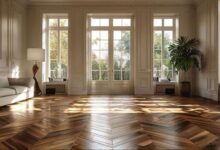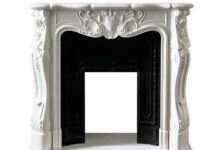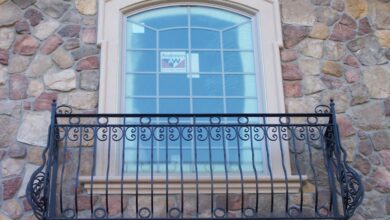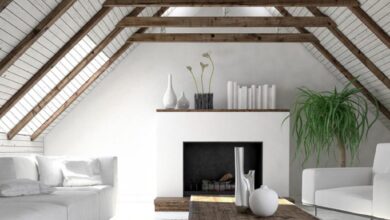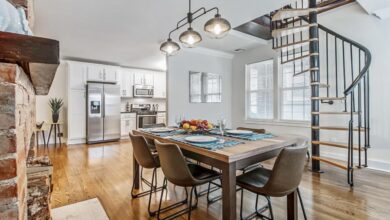French Architecture A Historical Overview
French architecture, a testament to centuries of artistic innovation and cultural evolution, boasts a rich tapestry of styles. From the soaring Gothic cathedrals to the elegant Baroque palaces and the neoclassical grandeur of Parisian boulevards, French architectural heritage reflects the nation’s history, its artistic sensibilities, and its enduring influence on global design. This exploration delves into the defining characteristics, influential figures, regional variations, and global impact of French architecture, revealing its multifaceted nature and lasting legacy.
We will journey through the various periods, examining the evolution of styles, the innovative techniques employed by master architects, and the impact of historical events on architectural trends. We’ll explore how geographical factors and the availability of materials shaped regional variations, and how French architectural principles spread across the globe, influencing designs in diverse cultural contexts. This comprehensive overview will showcase the enduring beauty and profound impact of French architecture on the world’s built environment.
Defining Characteristics of French Architecture
French architecture boasts a rich and diverse history, reflecting the nation’s evolving cultural, political, and technological landscapes. From the imposing Romanesque structures to the ornate Baroque palaces and the elegant Neoclassical designs, each period has left its indelible mark on the French architectural landscape, creating a unique and captivating legacy. This evolution showcases a fascinating interplay of influences and innovations, resulting in styles that are both distinctly French and globally recognized.
Evolution of French Architectural Styles
French architectural styles have undergone a significant transformation over the centuries. The Romanesque period (10th-12th centuries) is characterized by its robust, heavy stone structures, exemplified by the austere beauty of Romanesque churches. The subsequent Gothic period (12th-16th centuries) saw a dramatic shift towards verticality, with soaring cathedrals like Notre-Dame de Paris showcasing pointed arches, ribbed vaults, and stained-glass windows.
The Renaissance (15th-16th centuries) introduced classical elements, symmetry, and a focus on humanism, visible in the Château de Chambord’s blend of French Gothic and Italian Renaissance styles. The Baroque period (17th-18th centuries) emphasized grandeur, opulence, and dramatic movement, as seen in the Palace of Versailles. Finally, the Neoclassical period (late 18th-early 19th centuries) returned to classical ideals of order, harmony, and simplicity, influencing buildings like the Panthéon in Paris.
Key Distinguishing Features of French Architecture
Several key features differentiate French architecture from other European styles. The extensive use of stone, particularly limestone, is a hallmark of French construction, lending a unique texture and permanence to many structures. The emphasis on symmetry and proportion, particularly prevalent in Renaissance and Neoclassical architecture, creates a sense of balance and harmony. The integration of decorative elements, from intricate carvings and sculptures to elaborate ironwork, adds a layer of artistry and sophistication.
French architecture boasts a rich history, evident in its grand chateaux and charming townhouses. A key part of many French homes, regardless of size, is the Dining room (salle à manger) , often a focal point of family life and elaborate entertaining. These rooms, whether simple or ornate, reflect the overall aesthetic of the building and its period, showcasing the enduring elegance of French design.
Furthermore, the development of specific architectural features, such as the mansard roof and the distinctive dormers, further solidifies the unique identity of French architecture.
Comparison of Architectural Approaches Across Different Periods
The transition between architectural periods in France reveals fascinating shifts in aesthetic preferences and technological capabilities. While Romanesque architecture focused on solidity and strength, Gothic architecture prioritized height and light. The Renaissance incorporated classical elements, while Baroque architecture embraced dramatic ornamentation. Neoclassical architecture, in contrast, emphasized simplicity and order. This evolution reflects broader societal changes and evolving artistic sensibilities, with each style building upon and reacting against its predecessors.
Use of Materials in French Architecture
Stone, primarily limestone, has been the dominant material in French architecture for centuries. Its availability, durability, and ability to be intricately carved made it ideal for constructing everything from grand cathedrals to humble dwellings. Wood, particularly oak, was also widely used, especially for interior detailing, roofing, and smaller structures. The use of other materials like marble, brick, and iron evolved over time, reflecting both artistic trends and technological advancements.
The choice of material often dictated the style and character of a building, reflecting the resources available and the prevailing architectural aesthetic.
Comparison of Prominent French Architectural Styles
| Style | Defining Characteristics | Notable Examples | Materials |
|---|---|---|---|
| Romanesque | Rounded arches, thick walls, small windows, massive proportions | Saint-Sernin Basilica, Toulouse | Stone (primarily limestone) |
| Gothic | Pointed arches, ribbed vaults, flying buttresses, stained glass | Notre-Dame Cathedral, Paris | Stone (limestone), stained glass |
| Baroque | Ornate decoration, dramatic curves, elaborate facades, grandeur | Palace of Versailles | Stone, marble, stucco |
| Neoclassical | Symmetry, order, classical elements, restrained ornamentation | Panthéon, Paris | Stone (limestone), marble |
Notable French Architects and Their Contributions
French architecture boasts a rich history, shaped by the contributions of countless talented individuals. This section will highlight three influential architects, exploring their biographies, major works, innovative techniques, and lasting impact on the French architectural landscape. We will also briefly examine the work of a lesser-known but equally important figure.
Le Corbusier (1887-1965)
Le Corbusier, born Charles-Édouard Jeanneret, was a Swiss-French architect, designer, painter, urban planner, writer, and one of the pioneers of what is now called modern architecture. His work was characterized by a functionalist approach, emphasizing clean lines, open spaces, and the use of reinforced concrete. He believed architecture should serve the needs of modern society and championed a radical break from traditional styles.
His influence on urban planning and architectural design remains profound.
Le Corbusier’s innovative design techniques included the use of pilotis (reinforced concrete columns) to elevate buildings, freeing up ground-level space, and the incorporation of ribbon windows for maximum natural light. He also explored modular design, creating standardized elements that could be assembled in various configurations. His buildings often featured open floor plans, promoting a sense of fluidity and connection between spaces.
Architectural Masterpieces:
- Villa Savoye, Poissy, France: This iconic villa exemplifies Le Corbusier’s five points of architecture: pilotis, a free facade, a free plan, a ribbon window, and a roof garden. It showcases his innovative use of reinforced concrete and his focus on functional design. Its historical significance lies in its influence on the development of modern residential architecture.
- Unité d’Habitation, Marseille, France: This large-scale housing complex, often called “the vertical city,” represents Le Corbusier’s vision of urban living. Its innovative design features apartments with integrated amenities and communal spaces, reflecting his belief in creating self-sufficient communities. Its historical significance stems from its impact on social housing design worldwide.
- Notre-Dame-du-Haut, Ronchamp, France: This pilgrimage chapel showcases Le Corbusier’s exploration of organic forms and expressive use of concrete. Its undulating roofline and dramatic interior space challenge the conventions of religious architecture. Its historical significance is rooted in its artistic and spiritual impact, transcending purely functional concerns.
Eugène Viollet-le-Duc (1814-1879)
Eugène Viollet-le-Duc was a prominent French architect and architectural theorist who played a significant role in the Gothic Revival movement. He was a strong advocate for restoring historical buildings using historically accurate methods, rather than simply adapting them to modern tastes. His theoretical writings significantly influenced the understanding and appreciation of medieval architecture.
Viollet-le-Duc’s innovative approach to restoration involved meticulous research into historical building techniques and materials. He emphasized the importance of understanding the structural logic of Gothic architecture to accurately reconstruct damaged or deteriorated elements. His restoration projects involved not only repairing existing structures but also completing unfinished elements based on his scholarly understanding of the original design intent.
Architectural Masterpieces:
- Restoration of Notre-Dame Cathedral, Paris, France: Viollet-le-Duc’s extensive restoration work on Notre-Dame Cathedral is perhaps his most famous contribution. While some of his additions have been debated, his work significantly preserved this iconic structure and informed future approaches to historical preservation.
- Restoration of Carcassonne Citadel, Carcassonne, France: His work on this medieval citadel involved extensive reconstruction and restoration, shaping its current appearance and solidifying its status as a major historical landmark.
Pierre Puget (1620-1694)
Pierre Puget, a prominent sculptor and architect of the Baroque period, is less known for his architecture than his powerful sculptures. However, his architectural designs reflect a similar dynamism and grandeur, marked by a powerful sense of movement and drama. His work was deeply influenced by Italian Baroque architecture, but he adapted and reinterpreted these styles with a distinctly French sensibility.
Puget’s innovative designs often incorporated complex curves and dramatic interplay of light and shadow. He skillfully integrated sculpture and architecture, blurring the lines between these two art forms. He favored the use of rich materials and elaborate ornamentation, creating opulent and visually striking buildings.
Architectural Masterpieces:
- Hôtel de Ville, Toulon, France (partially attributed): While the attribution is debated, Puget’s influence is evident in the building’s powerful facade and dramatic use of sculptural elements.
A Lesser-Known Architect: Jacques Gabriel (1667-1742)
Jacques Gabriel, First Architect to the King under Louis XV, is a noteworthy figure whose contributions often get overshadowed by more flamboyant contemporaries. He was a master of the French neoclassical style, known for his elegant and harmonious designs. Gabriel’s architectural work was characterized by its balance, symmetry, and refined detailing, showcasing a sophisticated understanding of classical principles. His designs often featured grand colonnades, imposing facades, and expansive interior spaces, reflecting the grandeur and power of the French monarchy.
He is particularly known for his contributions to the development of the Place de la Concorde and the Château de Compiègne. His restrained elegance and mastery of proportion set him apart and had a lasting impact on French neoclassical architecture.
Regional Variations in French Architecture
France’s diverse geography and history have resulted in a rich tapestry of regional architectural styles. These variations aren’t merely aesthetic differences; they reflect the readily available building materials, local traditions, and the specific climatic conditions of each area. Understanding these regional distinctions provides a deeper appreciation for the complexity and beauty of French architecture.
Architectural Styles of Provence
Provence, in southeastern France, boasts a distinctive style characterized by its warm, sunny aesthetic. The region’s abundant sunshine and dry climate heavily influence the design. Buildings are often low-slung, with thick walls made of local stone, like limestone or ochre-colored sandstone, to provide insulation against the heat. Small, strategically placed windows minimize direct sunlight, while terracotta roof tiles, often in a warm, reddish-brown hue, are a common feature.
Many Provençal buildings incorporate arches, both rounded and pointed, adding to their characteristic elegance. The use of stucco, often painted in pastel shades of yellow, pink, or lavender, contributes to the region’s signature charm. Ornate wrought-iron balconies and shutters, often painted in vibrant colors, are also prevalent. The overall effect is one of relaxed elegance, reflecting the region’s Mediterranean character.
Architectural Styles of Normandy
In contrast to the sunny south, Normandy, in northwestern France, features a distinctly different architectural style. The region’s cooler, wetter climate and abundance of timber and stone have shaped its buildings. Half-timbered houses, with exposed wooden framing filled with brick or plaster, are a hallmark of Norman architecture, especially in rural areas. Stone, often granite or flint, is also widely used, particularly in larger buildings and churches.
The roofs are typically steeply pitched, often covered with slate or thatch, designed to shed rain effectively. Normandy’s architecture reflects a more robust and practical approach compared to the lighter, more decorative style of Provence. The architecture displays a more utilitarian nature, adapting to the harsh weather conditions.
Architectural Styles of the Loire Valley
The Loire Valley, famous for its chateaux, presents a unique blend of architectural influences. The region’s fertile lands and abundance of resources contributed to the construction of magnificent castles and manor houses. The architectural style of the Loire Valley is marked by its grandeur and elegance. The chateaux, often built from local stone, feature high roofs, tall towers, and elaborate facades.
The use of decorative elements, such as sculpted ornaments, intricate window designs, and decorative chimneys, is common. The style often blends elements of Gothic, Renaissance, and Baroque architecture, reflecting the evolving tastes of different periods. The vast scale of these structures stands in contrast to the smaller, more intimate buildings found in other regions of France.
Rural Versus Urban Architecture in France
The contrast between rural and urban architecture in France is striking. Rural architecture often emphasizes practicality and the use of locally sourced materials, reflecting a closer connection to the land. Buildings are frequently smaller and simpler, designed to serve functional purposes. In contrast, urban architecture, particularly in larger cities like Paris, displays a greater level of sophistication and complexity.
Larger buildings, more elaborate facades, and the use of more refined materials are characteristic of urban settings. This difference is largely due to the availability of resources, economic factors, and the greater density of populations in urban areas.
Geographical Influences on Regional Architectural Styles, French architecture
The geographical features of different regions of France have significantly impacted the development of their unique architectural styles. Coastal regions, for example, often utilize materials readily available from the sea, such as wood and stone. Mountainous regions, on the other hand, might incorporate materials like slate and timber, adapting to the challenges of building in steep, uneven terrain.
The climate also plays a significant role, with regions experiencing harsher weather conditions often developing architectural features designed to withstand strong winds, heavy rainfall, or extreme temperatures. The availability of specific resources, like clay for brickmaking or limestone for building, also directly influences the local architectural character.
Impact of Local Materials and Building Traditions
Local materials and building traditions are deeply intertwined with the development of regional architectural styles in France. The readily available materials often dictate the dominant construction methods and aesthetic features of a region. For instance, the abundance of timber in Normandy led to the development of half-timbered houses, while the readily available stone in Provence shaped the region’s characteristic stone buildings.
French architecture boasts a rich history, evident in its grand chateaux and charming townhouses. A key part of many French homes, regardless of size, is the Dining room (salle à manger) , often a focal point of family life and elaborate entertaining. These rooms, whether simple or ornate, reflect the overall aesthetic of the building and its period, showcasing the enduring elegance of French design.
These building traditions, passed down through generations, contribute to the distinct character of each region’s architecture. The knowledge and skills associated with working with local materials have been integral to shaping the unique architectural landscapes across France.
French architecture boasts a rich history, evident in its grand chateaux and charming townhouses. A key part of many French homes, regardless of size, is the Dining room (salle à manger) , often a focal point of family life and elaborate entertaining. These rooms, whether simple or ornate, reflect the overall aesthetic of the building and its period, showcasing the enduring elegance of French design.
Key Differences Between Provençal and Norman Architectural Styles
The following points highlight three key differences between the architectural styles of Provence and Normandy:
- Roof Pitch: Provençal buildings typically have low-pitched roofs, while Norman buildings often feature steeply pitched roofs to manage heavy rainfall.
- Wall Materials: Provence commonly uses limestone or sandstone, creating thick walls for insulation. Normandy utilizes timber framing (half-timbered) and granite or flint stone.
- Overall Aesthetic: Provençal architecture evokes a light, airy, and Mediterranean feel with pastel colors. Norman architecture presents a more robust, practical, and sometimes austere appearance.
French Architectural Influences on Other Styles
French architectural styles, renowned for their elegance and grandeur, have significantly impacted building design worldwide. From grand palaces to modest townhouses, the influence of French aesthetics can be seen across continents, adapting and evolving within diverse cultural contexts. This spread wasn’t merely a matter of imitation; it involved a complex interplay of cultural exchange, colonial expansion, and the inherent adaptability of French architectural principles.French architectural influence spread primarily through two channels: colonialism and the dissemination of architectural treatises and trained professionals.
The expansion of the French Empire led to the construction of numerous buildings in French colonial territories in Africa, Asia, and the Americas, often incorporating elements of French neoclassical, Baroque, and Beaux-Arts styles. Simultaneously, the publication of architectural books and the training of architects in French schools contributed to the global dissemination of French design principles, influencing architects and builders far beyond France’s borders.
Examples of French Architectural Influence in Non-French Buildings
The adoption of French architectural elements varied significantly based on local building traditions and available resources. However, certain features consistently appear in buildings influenced by French styles. These include the use of symmetrical facades, often featuring prominent central entrances, pilasters, and pediments. Mansard roofs, with their characteristic double slopes, are another recurring feature, particularly noticeable in buildings inspired by French Baroque or Second Empire styles.
Ornate detailing, including decorative moldings, carvings, and wrought-iron work, frequently embellishes buildings exhibiting French influence.
Adaptation of French Architectural Elements in Different Cultural Contexts
The adaptation of French architectural elements demonstrates a fascinating interplay between the imported style and the existing local traditions. For instance, colonial buildings in Southeast Asia often incorporated French architectural elements such as mansard roofs and symmetrical facades, but adapted these to suit the local climate and building materials. This resulted in buildings that combined French elegance with local vernacular features, creating a unique hybrid style.
Similarly, in Latin America, French neoclassical influences were often blended with Spanish colonial styles, resulting in buildings that combined the grandeur of French neoclassicism with the decorative richness of Spanish Baroque.
French architecture boasts a rich history, evident in its grand chateaux and charming townhouses. A key part of many French homes, regardless of size, is the Dining room (salle à manger) , often a focal point of family life and elaborate entertaining. These rooms, whether simple or ornate, reflect the overall aesthetic of the building and its period, showcasing the enduring elegance of French design.
Modification and Interpretation of French Architectural Principles in Different Contexts
French architectural principles, while widely adopted, were often modified to suit local conditions and preferences. For example, the use of local materials such as timber, brick, or stone often led to variations in the execution of French architectural details. The scale and ornamentation of buildings were also adapted to suit local contexts. Grand, monumental buildings might be appropriate in a colonial capital, but smaller, more modest structures reflecting French design elements would be more suitable for residential areas.
The adaptation frequently involved a simplification of the more elaborate French details, reflecting practical considerations and local aesthetics.
Visual Representation of a Building Showing French Architectural Influence Outside of France
Imagine a building in Hanoi, Vietnam. It’s a three-story colonial-era townhouse, built primarily from brick and featuring a symmetrical facade with a central entrance framed by pilasters and a small pediment. The roof is a mansard roof, albeit slightly shallower than its French counterparts, adapted to the tropical climate. The windows are tall and narrow, with decorative shutters, a common feature in Vietnamese architecture.
A wrought-iron balcony graces the second floor, echoing the elegance of French balconies but employing simpler designs. The building’s overall proportions are more modest than many grand French buildings, reflecting local building traditions and available resources, yet the symmetrical facade, mansard roof, and the use of pilasters clearly reveal its French architectural heritage. The color palette would be a soft, muted pastel, reflecting the local preference for lighter tones, contrasting with the sometimes bolder color schemes seen in French buildings.
The Impact of Historical Events on French Architecture
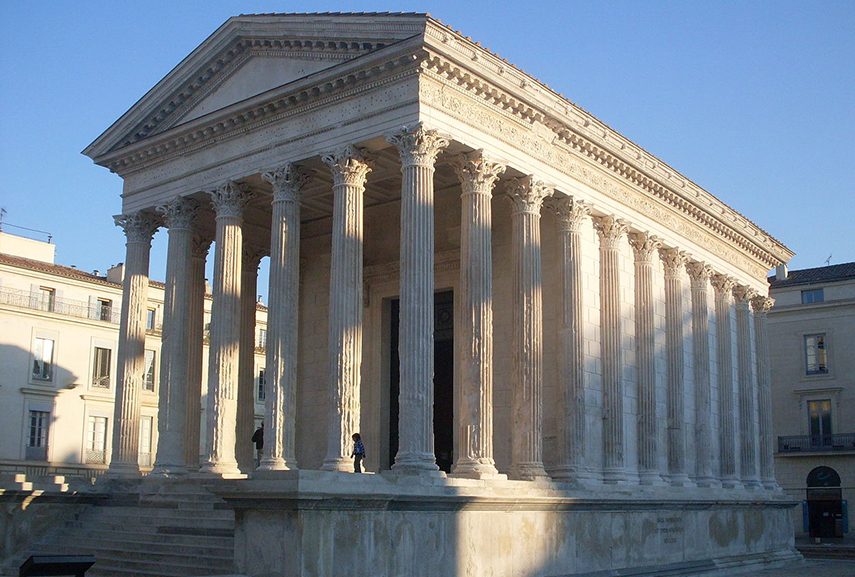
Source: cloudfront.net
French architecture, a rich tapestry woven through centuries, has been profoundly shaped by the nation’s tumultuous history. Major historical events, from revolutions and wars to periods of economic prosperity and decline, have left indelible marks on architectural styles, reflecting the social, political, and technological landscape of each era. The interplay between historical context and architectural expression provides a fascinating lens through which to understand French history and its cultural evolution.
French architecture boasts a rich history, evident in its grand chateaux and charming townhouses. A key part of many French homes, regardless of size, is the Dining room (salle à manger) , often a focal point of family life and elaborate entertaining. These rooms, whether simple or ornate, reflect the overall aesthetic of the building and its period, showcasing the enduring elegance of French design.
The relationship between historical events and architectural trends is multifaceted. Economic booms often fueled ambitious building projects, resulting in grand palaces and elaborate public works. Conversely, periods of war and instability often led to a decline in construction or a shift towards more austere styles. Similarly, social and political upheavals frequently triggered radical changes in architectural aesthetics, reflecting the changing values and aspirations of the populace.
The French Revolution and Neoclassicism
The French Revolution (1789-1799) marked a decisive break from the opulent Baroque and Rococo styles that characterized the preceding era. The revolution’s emphasis on republican ideals, civic virtue, and classical antiquity found its architectural expression in Neoclassicism. This style, characterized by its emphasis on symmetry, order, and simplicity, directly opposed the extravagance of the Ancien Régime. Buildings like the Panthéon in Paris, originally conceived as a church but later repurposed as a mausoleum for notable French figures, exemplify the shift towards a more austere and republican aesthetic.
French architecture boasts a rich history, evident in its grand chateaux and charming townhouses. A key part of many French homes, regardless of size, is the Dining room (salle à manger) , often a focal point of family life and elaborate entertaining. These rooms, whether simple or ornate, reflect the overall aesthetic of the building and its period, showcasing the enduring elegance of French design.
The use of classical elements, such as columns, pediments, and domes, conveyed a sense of stability and grandeur, reflecting the revolutionary government’s desire to establish a new order based on reason and classical principles. The revolutionary fervor also led to the destruction of many symbols of the monarchy, further contributing to the adoption of a new architectural language.
Napoleon and the Empire Style
Napoleon Bonaparte’s rise to power (1799-1815) ushered in the Empire style, a variation of Neoclassicism with its own distinct characteristics. While retaining the classical emphasis on symmetry and order, the Empire style incorporated more opulent and decorative elements, reflecting Napoleon’s imperial ambitions and the grandeur of his regime. The Arc de Triomphe, commissioned by Napoleon to commemorate his military victories, is a prime example of this style.
French architecture boasts a rich history, evident in its grand chateaux and charming townhouses. A key part of many French homes, regardless of size, is the Dining room (salle à manger) , often a focal point of family life and elaborate entertaining. These rooms, whether simple or ornate, reflect the overall aesthetic of the building and its period, showcasing the enduring elegance of French design.
Its imposing scale and ornate detailing celebrate military might and national glory, showcasing the emperor’s desire to project power and prestige. The use of Egyptian motifs, reflecting Napoleon’s Egyptian campaign, further adds to the style’s unique character. The patronage of Napoleon and his court significantly influenced the development and dissemination of the Empire style across France.
The Industrial Revolution and the Rise of New Materials
The Industrial Revolution (late 18th and 19th centuries) brought about significant technological advancements that transformed French architecture. The development of new materials, such as iron and steel, allowed for the construction of taller and more complex structures. The Eiffel Tower, built for the 1889 World’s Fair, epitomizes this technological innovation. Its revolutionary wrought-iron construction showcased the possibilities of industrial materials, marking a departure from traditional building methods and materials.
The use of iron also enabled the creation of larger spans, leading to the development of new architectural forms and designs. The Industrial Revolution also fostered the growth of urban centers, necessitating the construction of new housing, infrastructure, and public buildings, significantly altering the urban landscape.
Timeline of Major Historical Events and Architectural Styles
A concise timeline helps visualize the correlation between major historical events and shifts in architectural styles:
| Date | Historical Event | Architectural Style |
|---|---|---|
| 1789-1799 | French Revolution | Neoclassicism |
| 1799-1815 | Napoleonic Era | Empire Style |
| Late 18th – 19th Centuries | Industrial Revolution | Rise of Iron and Steel Construction |
| 1871 | Franco-Prussian War | A period of relative architectural stagnation, followed by a renewed focus on national identity reflected in architecture. |
| Late 19th – Early 20th Centuries | Belle Époque | Art Nouveau, Beaux-Arts |
Summary
From the medieval castles of the Loire Valley to the modern marvels of Paris, French architecture stands as a powerful symbol of national identity and artistic achievement. Its enduring influence on global design is undeniable, a testament to the creativity and skill of generations of French architects and builders. This exploration has only scratched the surface of this vast and complex subject, revealing the intricate interplay of history, culture, and artistic vision that has shaped French architecture into the remarkable legacy it is today.
Further exploration will undoubtedly unveil even more captivating details and fascinating stories within this rich architectural landscape.
Frequently Asked Questions
What are some common building materials used in French architecture?
Stone (limestone, especially), wood, and brick are prevalent, with choices often dictated by regional availability.
How did the French Revolution impact French architecture?
The Revolution ushered in a shift away from the opulent Baroque and Rococo styles towards Neoclassicism, reflecting a desire for simplicity and republican ideals.
Are there any significant differences between Parisian and rural French architecture?
Yes, Parisian architecture tends to be denser, more elaborate, and influenced by grander styles, while rural architecture often uses local materials and reflects simpler, more functional designs.
What is a notable example of French architectural influence outside of France?
Many buildings in the United States, particularly government buildings and universities, showcase Neoclassical influences clearly derived from French architectural styles.
How has modern technology impacted French architecture?
Modern technology has allowed for the use of new materials, innovative construction techniques, and more sustainable building practices, leading to a diverse range of contemporary architectural expressions.
